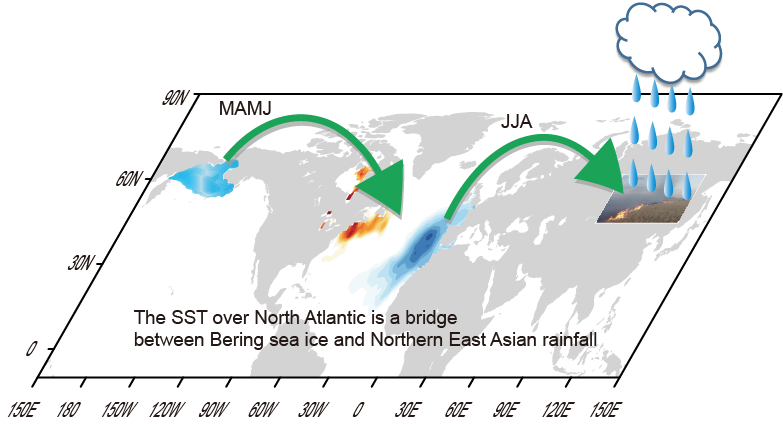Northeastern Asia is a vast region, stretching from Lake Baikal in Russia to China's northeastern provinces. This zone experiences marginal influences from the East Asian summer monsoon, as it contains both arid and semi-arid climate zones with various ecosystems. Plants and animals who live in the area are fragile and vulnerable to climate change. Climate change is complex, and its components can significantly influence agriculture, animal husbandry and socioeconomic development. In recent years, disastrous drought, sandstorms and wildfires, induced by insufficient precipitation, have caused huge ecological and economic losses. Research analyzing precipitation variation across Northeast Asia is critical to continue sustainable development within the region.
Sea ice melt season occurs in spring and summer, with Bering sea ice minimums typically observed in June. The Bering Sea ice cover in melt season may have a significant impact on Northeast Asian summer precipitation. A research team led by Professor GAO Yongqi of the Nansen-Zhu International Climate Centre, Institute of Atmospheric Physics, Chinese Academy of Sciences set out to find if any significant connections exist between the volume of melted sea ice and summer rainfall in Northeast Asia.
His study, published in
Advances in Atmospheric Sciences, found that when Bering Sea ice is at its maximum, persistent high pressure, therefore an anti-cyclonic wind pattern, develops over the North Atlantic Ocean. This wind pattern causes a "dipole" sea surface temperature (SST) distribution during summer, where eastern water remains cold, and western water warms up within the mid-latitude North Atlantic.
Furthermore, the study suggests that the SST dipole pattern triggers an upper-level atmospheric wave train, creating low pressure development anomalies in Northeast Asia. Low pressure systems feature upward vertical airflow, which efficiently extracts water from nearby bodies of water, such as the ocean. When low pressure develops more frequently, more precipitation is expected.
Mechanism on how the melt season Bering sea ice impacts on summer precipitation in Northeast Asia. (Image by TIAN Yurun)
This work is supported by the National Key R&D Program of China and the National Natural Science Foundation of China. TIAN Yurun is the first author of the paper.
Citation: Tian, Y. R., Y. Q. Gao, and D. Guo, 2021: The relationship between melt season sea ice over Bering Sea and summer precipitation over mid-latitude East Asia. Adv. Atmos. Sci., https://doi.org/10.1007/s00376-021-0348-z.
Media contact: Ms. LIN Zheng, jennylin@mail.iap.ac.cn

